Remington BS188A, BPS188A User Manual
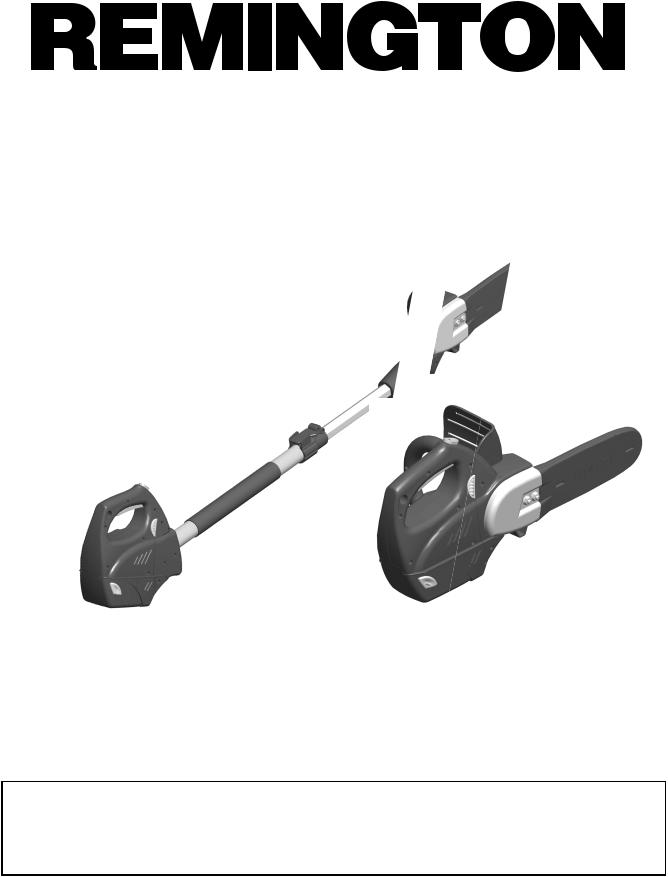
®
18 VOLT CORDLESS POLESAW
18 VOLT CORDLESS CHAINSAW
OWNER’S MANUAL
Polesaw Model |
Chain Saw Model |
BPS188A (8"/20.3 cm) |
BS188A (8"/20.3 cm) |
IMPORTANT: Read and understand this manual before assembling or operating this saw. Improper use of saw can cause severe injury. Keep this manual for future reference.
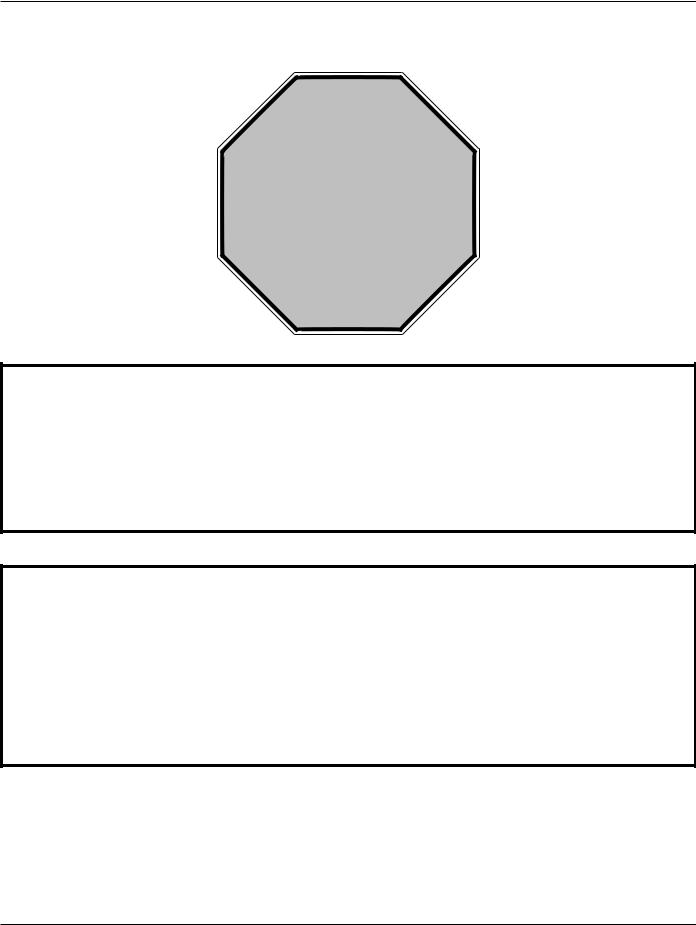
STOP
PARA
DO NOT RETURN PRODUCT TO STORE.
CALL 1-800-626-2237 FOR TECHNICAL ASSISTANCE For more information, visit www.remingtonpowertools.com
This manual is your guide to safe and proper operation of the saw. SAVE THESE INSTRUCTIONS.
Keep your purchase receipt for warranty coverage.
NO DEVUELVA EL PRODUCTO A LA TIENDA Para más información, www.remingtonpowertools.com
PARA AYUDA TÉCNICA LLAME AL 1-800-626-2237 Este manual es su guía para utilizar esta sierra eléctrica de
manera adecuada y segura. GUARDE ESTAS INSTRUCCIONES.
Guarde su recibo de compra para cobertura de la garantía.
www.remingtonpowertools.com |
2 |

INTRODUCTION
Your Remington Cordless Polesaw and Cordless Chainsaw may have been purchased together (as a 2-in-1 polesaw/chainsaw) or seperate (chainsaw only). If the chainsaw was purchased separately, the pole is available as an accessory and may be purchased by visiting the "On-Line Outlet" at www.remingtonpowertools.com.
CONTENTS |
|
IMPORTANT SAFETY INFORMATION....................................................................... |
4 |
Before Operating Saw.......................................................................................................... |
4 |
While Operating Saw ........................................................................................................... |
4 |
Kickback............................................................................................................................... |
5 |
Maintenance and Storage of Saw........................................................................................ |
5 |
Polesaw Trimming Precautions............................................................................................ |
6 |
UNPACKING................................................................................................................ |
6 |
PRODUCT IDENTIFICATION...................................................................................... |
7 |
Chain Saw............................................................................................................................ |
7 |
Polesaw................................................................................................................................ |
7 |
CHAIN TERMS AND DEFINITIONS............................................................................ |
8 |
RECHARGEABLE BATTERY...................................................................................... |
9 |
Protective Battery Terminal Cap........................................................................................... |
9 |
Safety Warnings................................................................................................................... |
9 |
Charging Battery ................................................................................................................ |
10 |
Important Charging Notes.................................................................................................. |
10 |
CHAIN SAW INFORMATION..................................................................................... |
11 |
Chain Saw Assembly ......................................................................................................... |
11 |
Saw Chain Tension ............................................................................................................. |
11 |
Oiling Chain........................................................................................................................ |
12 |
Cutting with the Chain Saw................................................................................................ |
12 |
Felling a Tree (Cutting Down a Tree) ................................................................................. |
12 |
Limbing a Tree ................................................................................................................... |
13 |
Bucking A Log .................................................................................................................... |
14 |
Trimming a Tree (Pruning) ................................................................................................. |
14 |
POLESAW INFORMATION....................................................................................... |
15 |
Polesaw Assembly ............................................................................................................. |
15 |
Adjusting Pole Length ........................................................................................................ |
15 |
Cutting with the Polesaw.................................................................................................... |
15 |
CLEANING AND MAINTENANCE............................................................................. |
16 |
Cleaning Saw Body............................................................................................................ |
16 |
Care of Guide Bar .............................................................................................................. |
16 |
Sharpening Saw Chain ...................................................................................................... |
16 |
Replacing Saw Chain......................................................................................................... |
17 |
STORAGE.................................................................................................................. |
18 |
TECHNICAL SERVICE.............................................................................................. |
18 |
REPLACEMENT PARTS AND ACCESSORIES....................................................... |
18 |
REPAIR SERVICE..................................................................................................... |
18 |
BATTERY RECYCLING............................................................................................. |
18 |
TROUBLESHOOTING............................................................................................... |
19 |
WARRANTY INFORMATION..................................................................................... |
20 |
ILLUSTRATED PARTS BREAKDOWN.................................................................... |
43 |
PARTS CENTRALS................................................................................................... |
45 |
ENGLISH
3 |
www.remingtonpowertools.com |
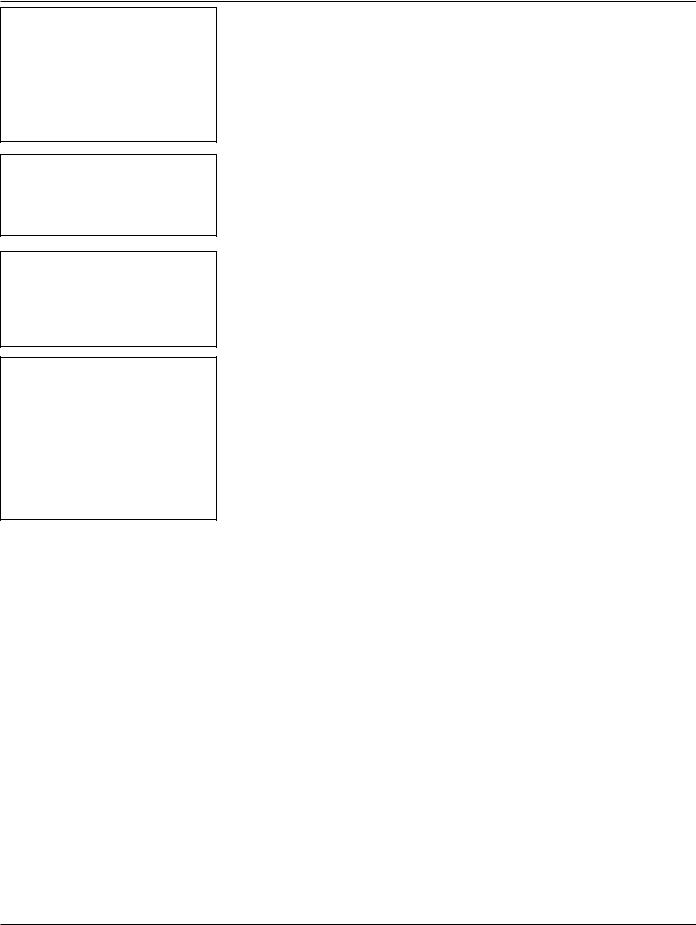
IMPORTANT SAFETY INFORMATION
READ ALL INSTRUCTIONS.
Make sure you read and understand all instructions in Important Safety Information. Improper use ofthischainsawcancausesevere injury or death from fire, electrical shock, body contact with moving chain, or falling wood.
 DANGER: Serious injury or death from electrocution if power lines are contacted. Never use near any electrical source, wires, or power lines.
DANGER: Serious injury or death from electrocution if power lines are contacted. Never use near any electrical source, wires, or power lines.
 WARNING: When using a battery operated chain saw, basic safety precautions should always be followed to reduce the risk of fire and injury to persons, including the following:
WARNING: When using a battery operated chain saw, basic safety precautions should always be followed to reduce the risk of fire and injury to persons, including the following:
 WARNING: For safe operation read and understand owners manual. Wear face shield (and/or safety glasses) and hard hat to protect against falling debris. Always have a clear work area, retreat path, and be aware of limb/branch location to avoid falling limbs and debris. Keep bystanders 50 ft(5m) away when operating saw. Store indoors.
WARNING: For safe operation read and understand owners manual. Wear face shield (and/or safety glasses) and hard hat to protect against falling debris. Always have a clear work area, retreat path, and be aware of limb/branch location to avoid falling limbs and debris. Keep bystanders 50 ft(5m) away when operating saw. Store indoors.
BEFORE OPERATING SAW
For safe operation read and understand this owner’s manual before operating saw.
Only well-instructed adults should operate saw. Never allow children to operate saw.
Keep Work Area Clean
Cluttered work areas invite injuries. Before cutting, always provide the following:
•clear work area
•secure footing
•planned retreat path from falling tree
Consider Work Area Environment
1.Do not operate saw
•in rain or snow
•in damp or wet areas
•where highly flammable liquids or gases are present
•while in a tree or on a ladder
•while on aerial booms, buckets, or platforms
2.Inspect tree before trimming or cutting down. Make sure there are no dead limbs or branches that may fall on you. Make allowance for branches to fall freely to the ground.
Use Right Tool
Use saw for cutting wood only.
•Do not use chain saw for purpose not intended.
•Do not use for cutting non-wood items.
Dress Properly
1.Wear snug-fitting clothes when operating saw. Do not wear loose clothing or jewelry. They can get caught in moving saw chain.
2.Wear hair covering to contain long hair.
Wear Safety Gear
Wear the following safety gear when operating saw:
•heavy-duty gloves (wear rubber gloves when working outdoors)
•steel-toed safety footwear with nonskid soles
•eye protection such as safety glasses, goggles, or face screen
•safety hard hat
•ear mufflers or ear plugs
•face or dust mask (if working in dusty areas)
Stay Alert
1.Watch what you are doing. Use common sense. Do not operate saw when you are tired.
2.Do not operate saw
•while under the influence of alcohol, medication, or drugs
•while in a hurry
Check for Damage
Do not operate saw
•if pole or saw is damaged, adjusted wrong, or not fully and securely assembled
•if trigger does not turn saw on and off. Chain must stop moving when you release trigger. Have faulty switch replaced by authorized service center (see Technical Service).
WHILE OPERATING SAW
Keep Work Area Clean
1.Keep work area clean. Cluttered areas invite injuries.
2.Do not use near power lines. Keep at least 10 feet away from electrical lines.
3.If two or more persons perform bucking and felling operations at the same time, provide plenty of distance between operations. Provide distance of at least twice the height of tree being felled.
4.Secure wood you are cutting by using clamps or chocks.
Keep Children, Bystanders, and
Animals Away
1.Only saw user should be in work area. Keep bystanders 50 feet (15m) away when operating saw.
2.Do not let visitors contact chain saw.
Use Right Tool
1.Do not use the polesaw to cut down trees. Use the chain saw without pole attachment and only if you are trained or have expert help.
2.Do not cut small brush and saplings with the polesaw. Use the chain saw only, with extreme care. Slender matter may catch in the chain and be whipped toward you. This could also pull you off balance.
Stay Alert
1.Stay alert. Use common sense while operating saw.
2.Grip chain saw firmly with both hands. Never operate chain saw with one hand. Never use hand guard as handle.
3.Grip polesaw securely. Place one hand on the pole and the other on the handle.
4.Keep finger off trigger until ready to make cut.
5.Before starting saw, make sure chain is not touching anything.
6.To guard against electrical shock, avoid body contact with grounded objects such as pipes, fences, and metal posts.
7.Keep all parts of body away from chain when saw is running.
8.When cutting limb or tree trunk that is under tension, use extreme caution. Be alert for wood springing back. When wood tension is released, limb could spring back and strike operator causing severe injury or death.
Do Not Force Saw While Cutting
Apply light pressure. It will do the job better and safer at the rate for which it was intended.
www.remingtonpowertools.com |
4 |
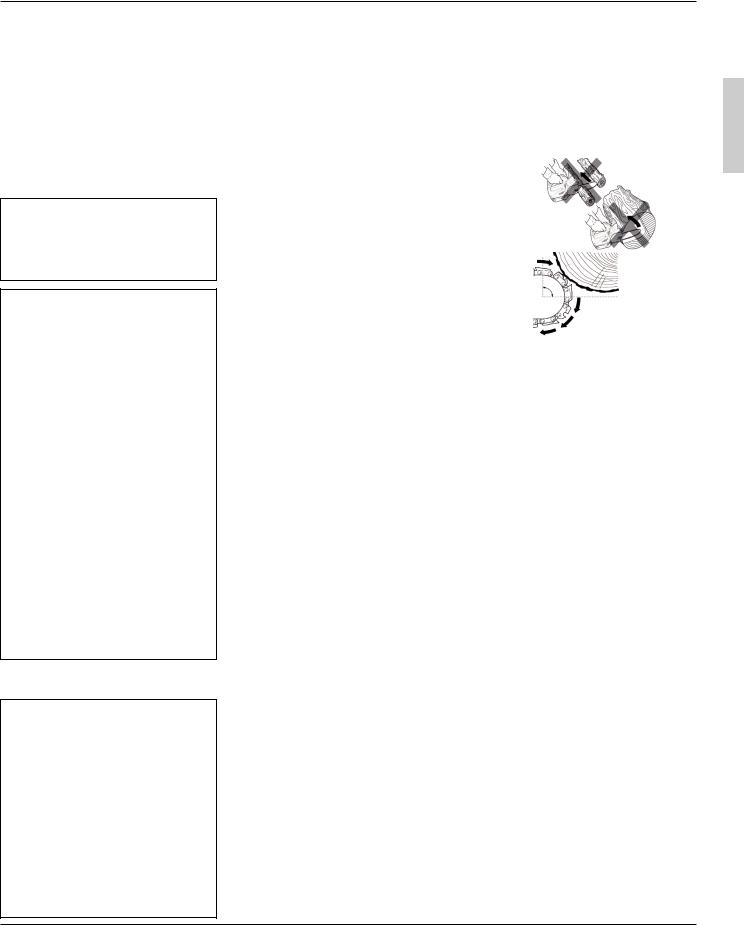
IMPORTANT SAFETY INFORMATION
Carrying Saw
Carry saw from one place to another
•with saw stopped
•with finger off trigger
•with guide bar and chain to rear
•Chain saw - by holding front handle (never use hand guard as handle)
•Polesaw - with telescoping pole returned to shortest position
•Polesaw - by holding the pole at the balance point (close to saw end)
•Remove battery and use scabbard when transporting saw.
 WARNING: This product contains chemicals known to the State of California to cause cancer or birth defects, or other reproductive harm.
WARNING: This product contains chemicals known to the State of California to cause cancer or birth defects, or other reproductive harm.
 WARNING: Some dust created by power sanding, sawing, grinding, drilling, and other construction activities contains chemicals known (to the state of California) to cause cancer, birth defects, or other reproductive harm. Some examples of these chemicals are:
WARNING: Some dust created by power sanding, sawing, grinding, drilling, and other construction activities contains chemicals known (to the state of California) to cause cancer, birth defects, or other reproductive harm. Some examples of these chemicals are:
•lead from lead-based paints
•crystalline silica from bricks and cement and other masonry products
•arsenic and chromium from chemically-treated lumber
Your risk from these exposures varies, depending on how often you do this type of work. To reduce your exposure to these chemicals: work in a well ventilated area, and work with approved safety equipment, such as those dust masks that are specially designed to filter out microscopic particles.
KICKBACK
 WARNING: Kickback may occur when the nose or tip of the guide bar touches an object, or when the wood closes in and pinches the saw chain in the cut. Tip contact in some cases may cause a lightning fast reverse reaction, kicking the guide bar up and back towards the operator. Pinching the saw chain along the top of the guide bar may push the guide bar rapidly back towards the operator. Either of these reactions may cause you to lose control of the saw which could result in serious injury to user.
WARNING: Kickback may occur when the nose or tip of the guide bar touches an object, or when the wood closes in and pinches the saw chain in the cut. Tip contact in some cases may cause a lightning fast reverse reaction, kicking the guide bar up and back towards the operator. Pinching the saw chain along the top of the guide bar may push the guide bar rapidly back towards the operator. Either of these reactions may cause you to lose control of the saw which could result in serious injury to user.
Kickback Safety Devices On This
Saw
This saw has a low-kickback chain and reduced kickback guide bar. Both items reduce the chance of kickback. Low-kickback saw chain is a chain which met the kickback performance requirements of ANSI B175.1. Kickback can still occur with this saw.
Follow assembly instructions on page 11. Do not remove front hand guard. Do not replace front hand guard with substitute.
The following steps will reduce the risk of kickback.
•Use both hands to grip saw while saw is running:
-For chain saw, use both hands to grip saw while saw is running. Use firm grip. Thumbs and fingers must wrap around saw handles.
-For polesaw, use one hand to grip the handle and the other hand to grip the pole. Use firm grip. Thumbs and fingers must wrap around pole and handle.
•Keep all safety items in place on saw. Make sure they work properly.
•Chain saw - do not overreach or cut above shoulder height.
•Polesaw - do not overreach or extend arms above shoulder height.
•Keep solid footing and balance at all times.
•Stand slightly to left side of saw. This keeps your body from being in direct line with chain.
•Do not let guide bar nose touch anything when chain is moving (see Figure 1).
•Never try cutting through two logs at same time. Only cut one log at a time.
•Do not bury guide bar nose or try plunge cut (boring into wood using guide bar nose).
•Watch for shifting of wood or other forces that may pinch chain.
•Use extreme caution when reentering a previous cut.
•Use low-kickback chain and guide bar supplied with this chain saw. Only replace these parts with chains and guide bars listed in this manual.
•Never use dull or loose chain. Keep chain sharp with proper tension.
Saw Maintenance and Kickback Safety
Follow maintenance instructions in this manual.Propercleaningofsawandchainand guide bar maintenance can reduce chances of kickback. Inspect and maintain saw after each use. This will increase the service life of your saw. Note: Even with proper sharpening, risk of kickback can increase with each sharpening.
Direction |
Do Not Let Guide |
|
|
|
Bar Touch Here |
90° |
|
|
|
Quadrant |
|
Figure 1 - Kickback Hazard Example: Do Not Let Nose of Guide Bar Touch Object While Chain is Moving
MAINTENANCE AND
STORAGE OF SAW
Disconnect Battery
Remove battery from saw
•when not in use
•before moving from one place to another
•before tensioning saw chain
•before servicing
•before changing accessories or attachments, such as saw chain and pole.
Check for Damage
Inspect saw before and after each use.
•Check saw closely if guard or other part has been damaged.
•Check for any damage that may affect operator safety or operation of saw.
•Check for alignment or binding of moving parts.
•Check for broken or damaged parts. Do not use saw if damage affects safety or operation. Have damage repaired by authorized service center.
ENGLISH
5 |
www.remingtonpowertools.com |
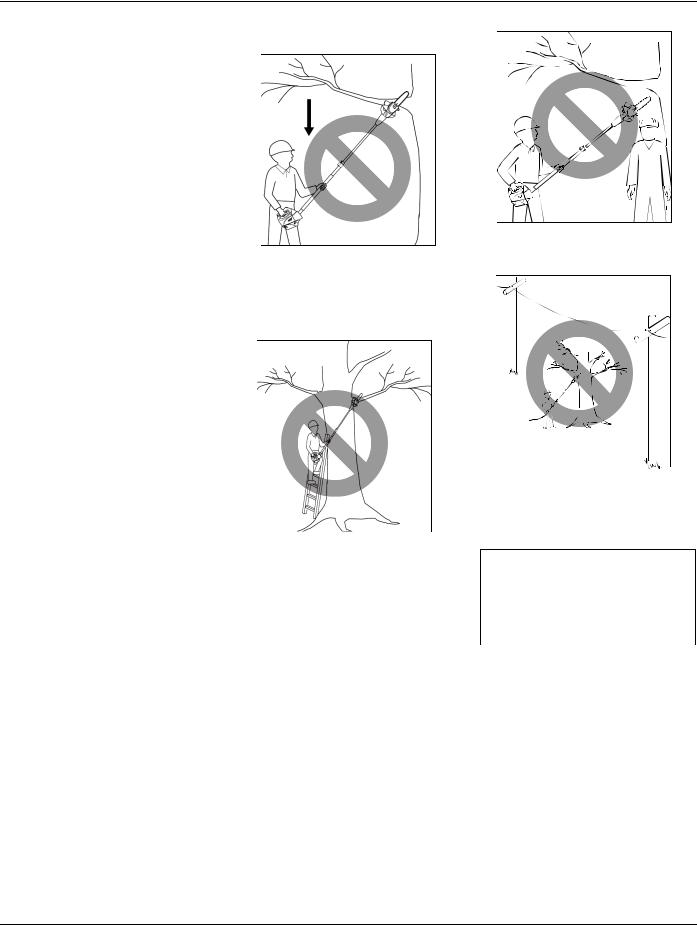
IMPORTANT SAFETY INFORMATION
General Maintenance
Maintain saw with care.
•Never expose saw to rain.
•Keep chain sharp, clean, and lubricated for better and safer performance.
•Follow steps outlined in this manual to sharpen chain.
•Keep handles dry, clean, and free of oil and grease.
•Keep all screws and nuts tight.
•Keep power cord on battery charger away from heat, oil, and sharp edges.
Service
When servicing, use only identical replacement parts.
Storage
When not in use, always store saw
•with battery removed
•in a high or locked place, out of children’s reach
•in a dry place
•with scabbard over guide bar
•indoors
Save these instructions. It is your guide to safe and proper operation of this saw.
POLESAW TRIMMING
PRECAUTIONS
Never stand directly under the limb you are trimming. Always position yourself out of the path of falling debris.
Never stand on a ladder or other type of unstable support while using the polesaw.
Always use both hands to operate polesaw. Keep a firm, steady pressure on the polesaw while cutting but do not try to force the saw through the wood.
Do not use the polesaw to cut limbs larger in diameter than the length of the guide bar.
Keep other persons away from cutting end of polesaw and at a safe distance from work area.
Do not use polesaw near cable, electricpowerortelephonelines.Maintain a minimum clearance of 10 feet from all power lines.
IMPORTANT:Readandunderstand this manual before assembling or operating this chain saw. Improper use of saw can cause severe injury. Keep this manual for future reference.
UNPACKING
1.Remove all items from carton.
2.Check all items for any shipping damage. If you find any damage or if any parts are missing, promptly inform dealer where you bought chain saw.
www.remingtonpowertools.com |
6 |
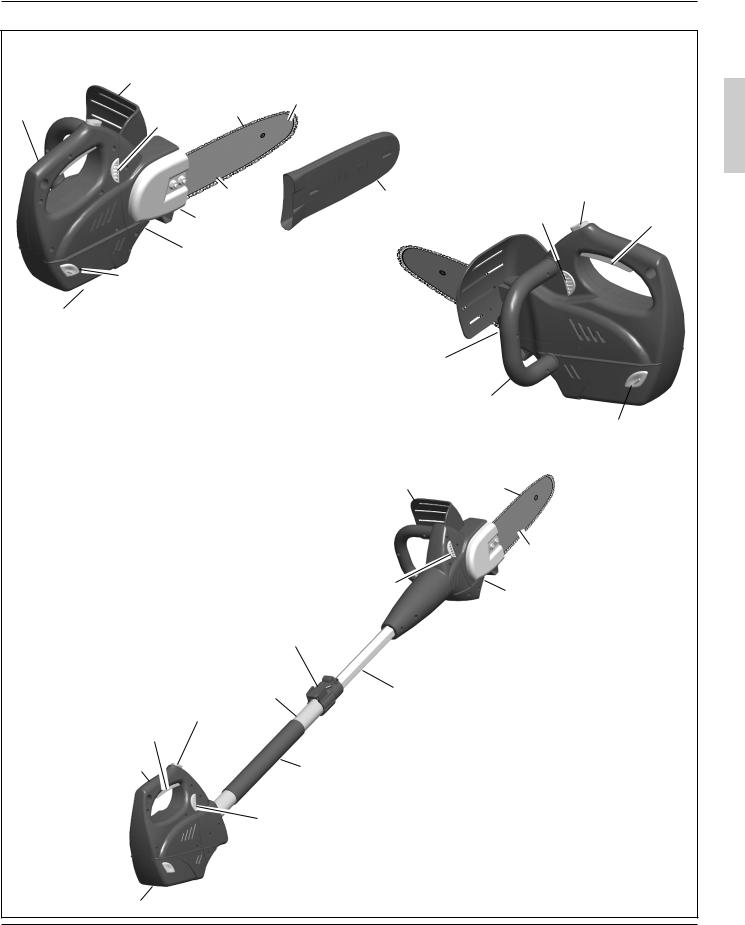
PRODUCT IDENTIFICATION
CHAIN SAW
Front Hand
Guard
|
Handle |
Saw |
Guide Bar Nose |
Rear Handle |
Chain |
|
|
|
Release |
|
|
|
Button |
|
|
Guide |
|
|
Trigger |
|
|
|
Lockout |
||
Bar |
Scabbard |
Handle Release |
||
|
||||
Sprocket |
|
|
||
|
Button |
Trigger |
||
Cover |
|
|||
|
|
|
Power
Head
Battery Release
Button
Battery
Spike
|
Front |
|
Handle |
|
Battery Release |
|
Button |
|
|
POLESAW |
|
Hand Guard |
Saw Chain |
|
Guide Bar |
Handle Release |
|
Button |
Power Head |
|
Clamping
Lever
Outer Pole |
Inner Pole |
Trigger
Lockout
Trigger
Handle
Grip Area
Handle Release
Button
 Battery Release
Battery Release
Battery Button
ENGLISH
7 |
www.remingtonpowertools.com |

CHAIN SAW TERMS AND DEFINITIONS
Bucking Process of cutting a felled tree or log into lengths.
Felling Process of cutting down a tree.
Felling Cut Final cut when felling a tree. Make this cut on opposite side of tree from notching cut.
Front Handle Located at front of saw body.
Front Hand Guard Shield between front handle and guide bar. Protects left hand while using saw.
Guide Bar Metal bar that extends from saw body. The guide bar supports and guides chain.
Guide Bar Nose Tip or end of guide bar.
Inner Pole The moveable section of tubing to which the saw is attached.
Kickback Quick backward and upward motion of guide bar. Kickback may occur when tip of guide bar touches an object while chain is moving. The guide bar will kick up and back towards operator.
Limbing Process of cutting limb(s) from a felled tree.
Low-Kickback Chain Chain that reduces chance of kickback as required by ANSI B175.1.
Normal Cutting Position Stance used while making bucking and felling cuts.
Notching Cut Notch cut in tree that directs fall of tree.
Outer Pole Retains the moveable inner pole.
Power Head Chain saw without chain and guide bar. Also known as saw body.
Pushback (Kickback, Pinch) Rapid pushback of chain saw. Pushback may occur if chain along top of guide bar is pinched, caught, or contacts a foreign object.
Rear Handle Handle located at rear of saw body.
Reduced Kickback Guide Bar Guide bar that reduces chance of kickback.
Replacement Chain Chain that complies with ANSI B175.1 when used with a specific saw. It may not meet ANSI requirements when used with other saws.
Saw Chain (Chain) Loop of chain having cutting teeth for cutting wood. The motor drives chain. The guide bar supports chain.
Spiked Bumper (Spike) Pointed teeth at front of saw body beside guide bar. Keep spiked bumper in contact with wood when felling or bucking. It helps maintain position of saw while cutting.
Sprocket Toothed wheel that drives chain.
Switch Device that completes or interrupts electrical circuit to motor of saw.
Switch Linkage This device connects switch to trigger. It moves switch when you squeeze trigger.
Trigger Lockout Device that reduces accidental starting of saw.
Trigger Device that turns saw on and off. Squeezing trigger turns saw on. Releasing trigger turns saw off.
Trimming (Pruning) Process of cutting limb(s) from a living tree.
Undercut An upward cut from underside of log or limb. This is done while in normal cutting position and cutting with top of guide bar.
www.remingtonpowertools.com |
8 |
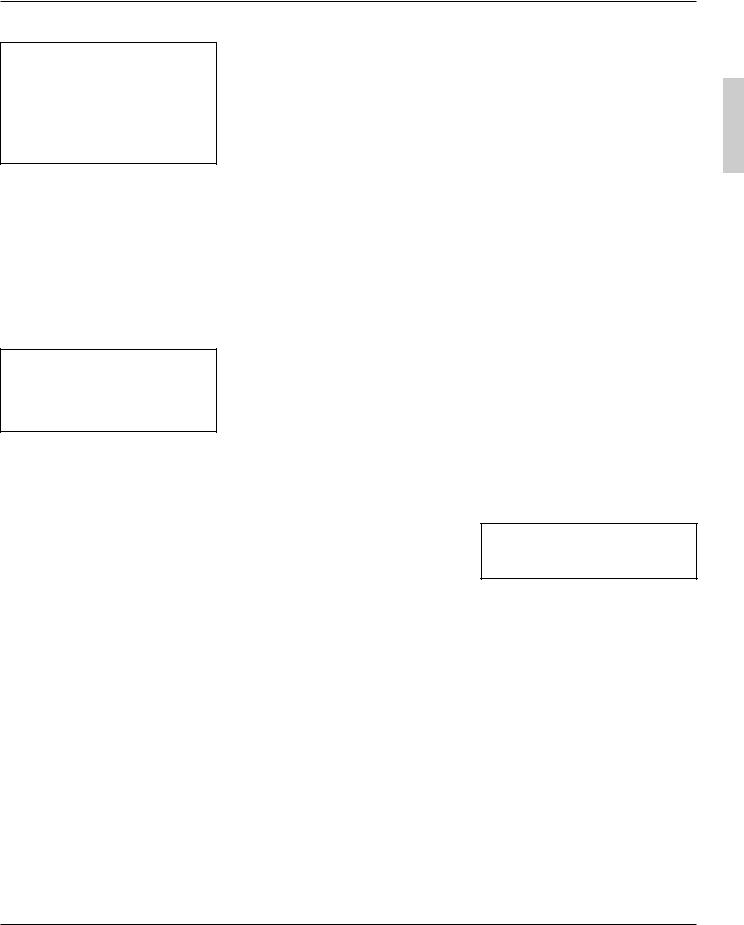
RECHARGEABLE BATTERY
PROTECTIVE BATTERY TERMINAL CAP
 WARNING: Do not store or carry battery so that metal objects can contact exposed battery terminals. For example, do not place battery in aprons, pockets, tool boxes, product kit boxes, drawers, etc. with loose nails, screws, keys, jewelry etc. without battery cap.
WARNING: Do not store or carry battery so that metal objects can contact exposed battery terminals. For example, do not place battery in aprons, pockets, tool boxes, product kit boxes, drawers, etc. with loose nails, screws, keys, jewelry etc. without battery cap.
A protective battery terminal cap is provided for use whenever the battery is out of the tool or charger. Remove cap before placing battery in charger or tool.
SAFETY WARNINGS
1.This manual contains important safety and operating instructions.
2.Before using battery charger, read all instructions and cautionary markings on battery charger, battery pack, and product using battery pack.
 CAUTION: To reduce the risk of injury, charge only Remington brandbatteries.Othertypesofbatteries may burst causing personal injury and damage.
CAUTION: To reduce the risk of injury, charge only Remington brandbatteries.Othertypesofbatteries may burst causing personal injury and damage.
3.Do not expose charger to rain or snow.
4.Use of an attachment not recommended or sold by Remington brand may result in a risk of fire, electric shock, or injury to persons.
5.To reduce risk of damage to electric plug and cord, pull by plug rather than cord when disconnecting charger.
6.An extension cord should not be used unless absolutely necessary. Use of improper extension cord could result in a risk of fire, electric shock or electrocution.
a.Two-wire cords can be used with 2-wire or 3-wire extension cords. Only round jacketed extension cords should be used, and we recommend that they be listed by Underwriters Laboratories (U.L.). If the extension is to be used outside, the cord must be suitable for outdoor use. Any cord marked for outdoor use can also be used for indoor work. The letters “W” or “WA” on the cord jacket indicate that the cord is suitable for outdoor use.
b.An extension cord must have adequate wire size (AWG or American Wire Gauge) for safety, and to prevent loss of power and overheating. The smaller the gauge number of the wire, the greater the capacity of the cable; that is, 16 gauge has more capacity than 18 gauge. When using more than one extension to make up the total length, be sure each extension contains at least the minimum wire size.
CHART FOR MINIMUM WIRE SIZE (AWG) OF EXTENSION CORDS NAMEPLATE RATING AMPS – 0
– 10.0
Cord |
AWG Cord |
Length |
Size |
|
|
25 feet |
18 AWG |
|
|
50 feet |
18 AWG |
|
|
100 feet |
16 AWG |
|
|
150 feet |
14 AWG |
|
|
7. Use only the supplied charger (P/ N 121397-01)when charging. The use of any other charger could damage the battery or create a hazardous condition.
8.Use only one charger when charging.
9.Use only Remington RB18V OR RBE18V battery packs with this product.
10.Do not attempt to open the charger. There are no customer serviceable parts inside. If damaged, call DESA Power Tools Technical Service.
11.DO NOT incinerate the battery pack even if they are severely damaged or completely worn out. The batteries can explode in a fire.
12.A small leakage of liquid from the battery pack cells may occur under extreme usage, charging, or temperature conditions. This does not indicate a failure. However, if the outer seal is broken and this leakage gets on your skin:
•Wash quickly with soap and water.
•Neutralize with a mild acid such as lemon juice or vinegar.
•If the battery liquid gets in your eyes, flush them with clean water for a minimum of 10 minutes and seek immediate medical attention.
MEDICAL NOTE: The liquid is a 25-35% solution of potassium hydroxide.
ENGLISH
9 |
www.remingtonpowertools.com |
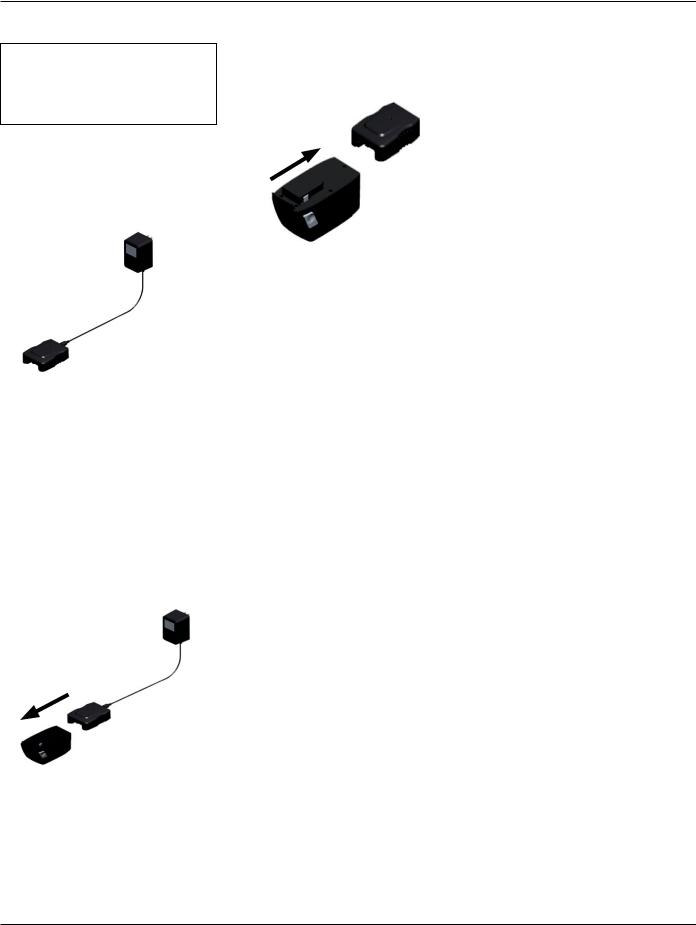
RECHARGEABLE BATTERY
CHARGING BATTERY
The battery pack is not fully charged at the factory. Before attempting to charge the battery pack, thoroughly read all Safety Instructions.
The charger is designed to use standard household 120 volt 60 Hz power.
1.Plug cord from charger into charger base. (See Figure 2)
4.Unplug charger. Remove the charger by sliding off (See Figure 4).
5.Place the battery pack in the tool and be certain that it is inserted fully into the tool cavity until it “clicks” into place.
Figure 2 - Plug Charger into Base
2.Plug the charger into any standard 120 Volt 60 Hz electrical outlet. IMPORTANT: Do not charge by means of an engine generator or DC power source. Use only 120V AC.
3.Slide the charger onto the battery pack as shown in Figure 3. The LED will light up, Let the battery pack charge until red LED turns off. After the initial charge, under normal usage, your battery pack should be fully charged in 3 to 9 hours.
Figure 3 - Slid Charger onto
Battery
Figure 4 - Remove Charger
IMPORTANT CHARGING NOTES
1.After normal usage, your battery pack should be fully charged in 3 to 9 hours. If the battery pack is run-down completely, it may take up to 9 hours to become fully charged. Your battery pack was sent from the factory in an uncharged condition. For best performance charge battery until red LED turns off. Allow the battery to cool down 30 minutes before charging after using the saw. NOTE: A hot battery placed in the charger will not charge.
2.DO NOT charge the battery pack in an air temperature below 40°F (4,5 °C) or above 105°F (40,5 °C). This is important and will prevent serious damage to the battery pack. Longest life and best performance can be obtained if battery pack is charged when air temperature is about 75°F (24°C).
3.While charging, the charger may hum and become warm to touch. This is a normal condition and does not indicate a problem.
4.If the battery pack does not charge properly
•Check current at receptacle by plugging in a lamp or other appliance.
•Check to see if receptacle is connected to a light switch which turns power off when you turn out the lights.
•Move charger and battery pack to a surrounding air temperature of 40°F (4,5°C) to 105°F (40,5 °C)
•If the receptacle and temperature are OK, and you do not get proper charging contact DESA Power Tools.
5.The battery pack should be recharged when it fails to produce sufficient power on jobs which were easily done previously. DO NOT CONTINUE using product with its battery pack in a depleted condition.
6.To prolong battery life, avoid leaving the battery pack on charger for extended periods of time (over 30 days without use). Although overcharging is not a safety concern, it can significantly reduce overall battery life.
7.The battery pack will reach optimum performance after being cycled 5 times during normal usage. There is no need to run the batteries down completely before recharging. Normal usage is the best method of discharging and recharging the batteries.
www.remingtonpowertools.com |
10 |
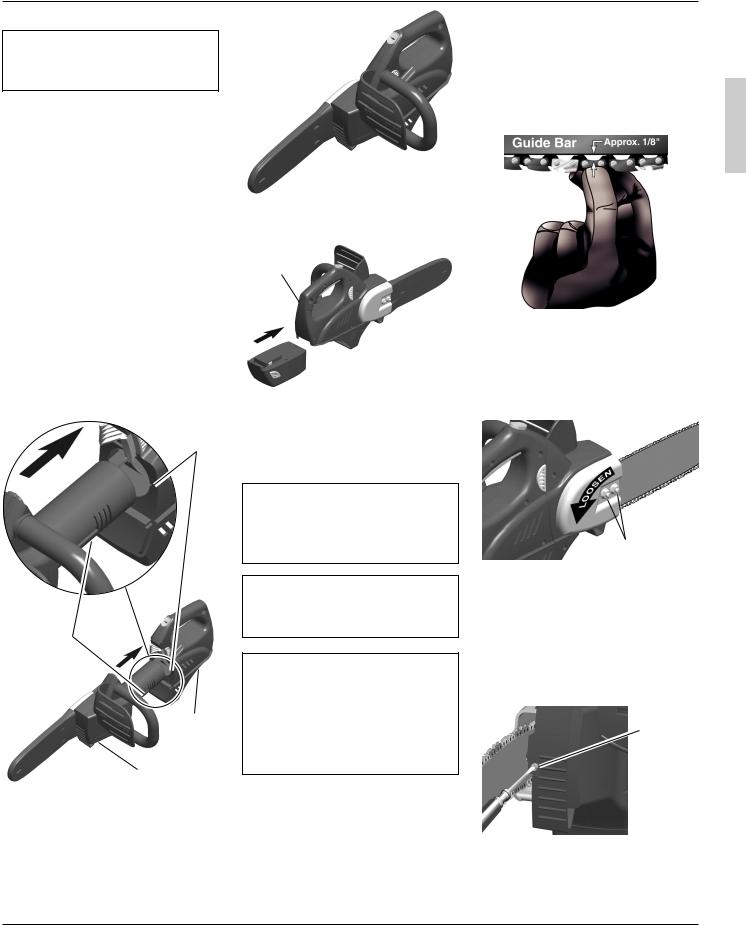
CHAIN SAW INFORMATION
CHAIN SAW ASSEMBLY
 WARNING: Cutting edges on chain are sharp. Use protective gloves when handling chain.
WARNING: Cutting edges on chain are sharp. Use protective gloves when handling chain.
1.Align rib on chain saw power head with groove in main handle (see Figure 5).
2.Slide power head into main handle until units “snap” together (see Figure 6). IMPORTANT: Both release buttons on main handle must be fully engaged.
3.Slide battery onto main handle until release buttons “snap” together (see Figure 7).
Note: Fully charge battery before using for first time. See Charging Battery.
NOTE: Your Remington Cordless Polesaw and Cordless Chainsaw may have been purchased together (as a 2-in-1 polesaw/ chainsaw) or seperate (chainsaw only). If the chainsaw was purchased separately, the pole is available as an accessory and may be purchased by visiting the "On-Line Outlet" at www.desatech.com.
Groove
Rib
Main
Handle
Power Head
Figure 5 - Align Power Head with
Handle
Figure 6 - Assembled Power Head
Main Handle
Main Handle
 Battery
Battery
Figure 7 - Assemble Battery onto Main
Handle
SAW CHAIN TENSION
 WARNING:Removebatteryfrom chainsawbeforeadjustingsawchain tension. Severe injury or death could occur from body contact with moving chain.
WARNING:Removebatteryfrom chainsawbeforeadjustingsawchain tension. Severe injury or death could occur from body contact with moving chain.
 WARNING: Cutting edges on chain are sharp. Use protective gloves when handling chain.
WARNING: Cutting edges on chain are sharp. Use protective gloves when handling chain.
 WARNING: Maintain proper chaintensionalways.Aloosechain will increase the risk of kickback.A loose chain may jump out of guide bar groove. This may injure operator and damage chain. A loose chain will cause chain, guide bar, and sprocket to wear rapidly.
WARNING: Maintain proper chaintensionalways.Aloosechain will increase the risk of kickback.A loose chain may jump out of guide bar groove. This may injure operator and damage chain. A loose chain will cause chain, guide bar, and sprocket to wear rapidly.
Note: The saw chain tension is properly set at the factory. A new chain will stretch. Check new chain tension frequently (after disconnecting battery) during the first 2 hours of operation. Allow chain to cool down. Follow steps below to check saw chain tension.
1.Remove battery from chain saw.
2.Place chain saw on a firm surface to check chain tension.
3.Pull chain with light force 1/8" away from bottom of guide bar and release (see Figure 8). If chain lightly snaps back into place, tension is correct. A slight sag (1/16" or less) between chain and bottom of guide bar is acceptable.
Figure 8 - Check Chain Tension
Saw Chain Tension Adjustment
1.Loosen guide bar nuts before adjusting chain (see Figure 9).
Guide Bar Nuts
Figure 9 - Loosen Guide Bar Nuts
2.Turn adjusting screw on front of power head clockwise until slack is out of chain (see Figure 10).
3.Wearing protective gloves, pull down on chain to check chain tension (See Step 3 Saw Chain Tension).
Adjusting
Screw
Figure 10 - Turning Adjusting Screw
ENGLISH
11 |
www.remingtonpowertools.com |
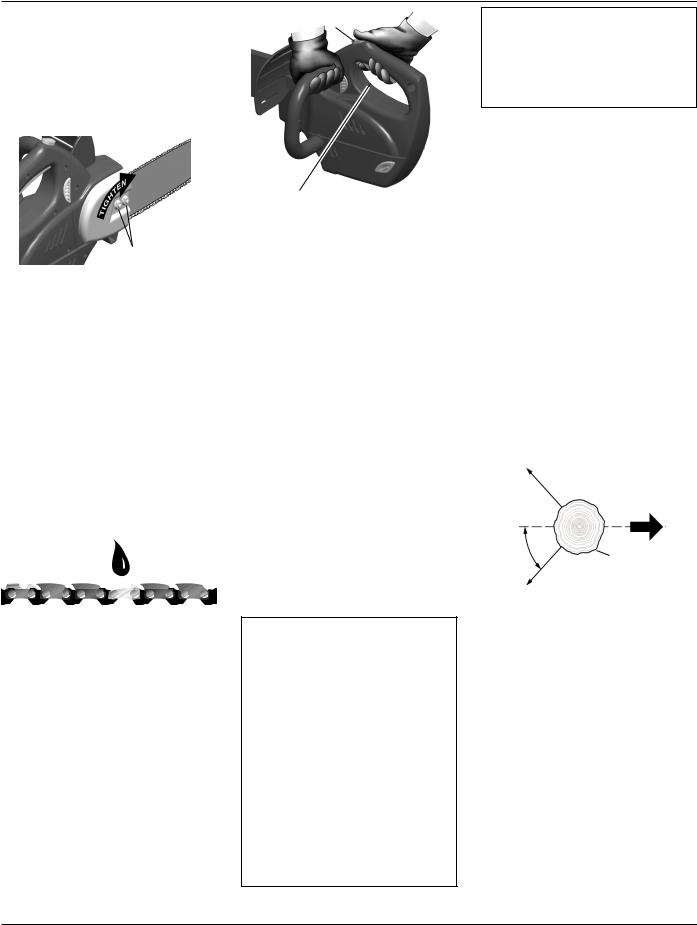
CHAIN SAW INFORMATION
4.Do not over-tension chain. Over-ten- sioning will cause excessive wear and will reduce the life of the guide bar and chain. Over-tensioning also reduces the amount of cuts per battery charge.
5.After chain tension is correct, tighten guide bar nuts firmly (see Figure 11).
Guide Bar
Nuts
Figure 11 - Tighten Guide Bar Nuts
OILING CHAIN
IMPORTANT: Applying oil to the chain and guide bar reduces friction and excessive wear. Improper oiling will cause excessive wear and reduce the life of the chain and guide bar.
1.Fill included squeeze bottle with SAE #30 or #40 motor oil or bar chain oil.
2.Apply several drops of oil between chain and guide bar (see Figure 12.
Note: Oil should be applied before each use and every 5 minutes during continuous use.
Oil Chain
Frequently
Guide Bar
Figure 12 - Applying Oil to Chain
CUTTING WITH THE CHAIN SAW
1.Attach battery to saw.
2.Make sure section of log to be cut is not laying on ground. This will keep chain from touching ground as it cuts through log. Touching ground with moving chain will dull chain.
3.Use both hands to grip saw. Always use left hand to grip front handle and right hand to grip rear handle. Use firm grip. Thumbs and fingers must wrap around saw handles (see Figure 13).
4.Make sure your footing is firm. Keep feet apart. Divide your weight evenly on both feet.
Trigger Lockout
Trigger
Figure 13 - Trigger Lockout and Trigger Location
5.When ready to make a cut, press in trigger lockout with right thumb and squeeze trigger (see Figure 13). This will turn saw on. Releasing trigger will turn saw off. Always turn saw on before contacting saw chain with log.
6.When starting a cut, place moving chain against wood. Hold saw firmly in place to avoid possible bouncing or skating (sideways movement) of saw.
7.Guide saw using light pressure. Do not force saw. The motor will overload and can burn out. It will do the job better and safer at the rate for which it was intended.
8.Remove saw from a cut with saw running. Stop saw by releasing trigger. Make sure chain has stopped before setting saw down.
9.Practice until you can maintain a steady, even cutting rate.
FELLING A TREE (Cutting
Down a Tree)
 WARNING:
WARNING:
•Avoid kickback. Kickback can result in severe injury or death.SeeKickback,page5, to avoid risk of kickback.
•Do not fell a tree without ample skill or expert help.
•Keep children, animals, and bystanders away from area when felling a tree.
•If two or more persons perform bucking and felling operations at the same time, provide ample distance betweenoperations.Provide distance of at least twice the height of tree being felled.
 WARNING: When felling a tree, be aware of your surroundings. Do not endanger any person, strike utility lines, or cause property damage. If tree strikes utility lines, contact utility company at once.
WARNING: When felling a tree, be aware of your surroundings. Do not endanger any person, strike utility lines, or cause property damage. If tree strikes utility lines, contact utility company at once.
Felling is the process of cutting down a tree. Make sure your footing is firm. Keep feet apart.Divideyourweightevenlyonbothfeet. Follow directions below to fell a tree.
Before Felling a Tree
1.Before felling, inspect tree. Make sure there are no dead limbs or branches that may fall on you. Study natural lean of tree, location of larger branches, and wind direction. This will help you judge which way tree will fall.
2.Clear work area around tree.
3.Plan and clear a retreat path before felling. Make retreat path opposite to planned direction of fall of tree and at 45° angle (see Figure 14).
4.Remove dirt, stones, loose bark, nails, staples, and wire from tree where you will make felling cuts.
5.Stay on uphill side when felling tree. Tree could roll or slide downhill after falling.
Retreat Path
Direction of Fall
45°
Tree
Retreat Path
Figure 14 - Retreat Path From Tree
www.remingtonpowertools.com |
12 |
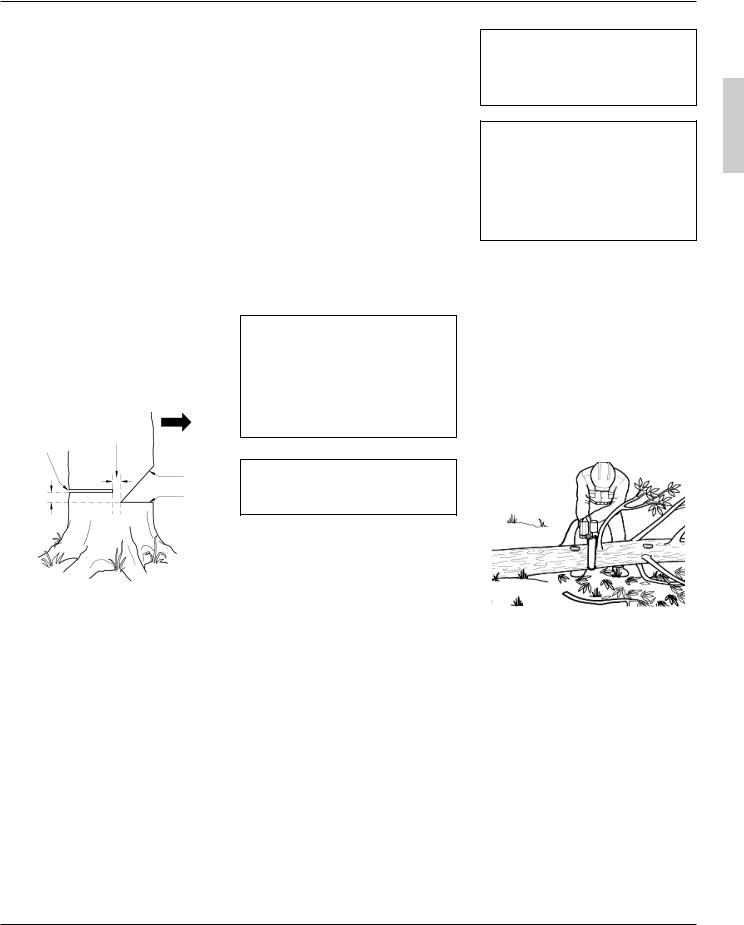
CHAIN SAW INFORMATION
Felling Procedure
A) Felling Notch
A properly placed felling notch will determine direction tree will fall. Place felling notch on side of tree in direction you want tree to fall (see Figure 15).
Follow directions below to create a felling notch.
1.Make lower notch cut as close to ground as possible. Hold saw so guide bar is horizontal. Cut 1/3 the diameter of tree trunk (see Figure 15). Note: Always make this horizontal lower notch cut first. If you make this cut second, tree can pinch chain or guide bar.
2.Start upper notch cut the same distance above first cut as first cut is deep.
Example: If lower notch cut is eight inches deep, start upper notch cut eight inches above it. Cut downward at 45° angle. The upper notch cut should meet end of lower notch cut (see Figure 15).
3.Remove tree trunk wedge created by notching cuts.
|
|
Direction of Fall |
||
3rd Cut - |
Hinge |
|
||
Felling Cut |
2nd Cut - |
|||
|
|
|||
|
|
Upper |
||
|
|
|
||
|
2" |
|
Notch |
|
|
|
Cut |
||
|
1st Cut - |
|
2" |
Lower |
|
Notch |
||
|
||
|
Cut |
B) Felling Cut
1.Make felling cut two inches higher than lower notch cut and on opposite side of tree (see Figure 15). Keep felling cut parallel to lower notch cut.
2.Cut towards notch.
3.As felling cut nears hinge, tree should begin to fall. Note: If needed, drive wedges into felling cut to control direction of fall. If tree settles back and pinches chain, drive wedges into felling cut to remove saw. Only use wedges made of wood, plastic, or aluminum. Never use wedge made of steel. This could cause kickback and damage to chain.
4.When tree begins to fall, quickly
•remove saw from felling cut
•release trigger to turn saw off
•put saw down
•exit area using retreat path
 WARNING: Do not cut all the way through tree. Leave about two inches of tree diameter uncut directly behind felling notch (see Figure 15). This uncut portion acts as a hinge. The hinge helps keep tree from twisting and falling in wrong direction.
WARNING: Do not cut all the way through tree. Leave about two inches of tree diameter uncut directly behind felling notch (see Figure 15). This uncut portion acts as a hinge. The hinge helps keep tree from twisting and falling in wrong direction.
 WARNING: Be alert for falling overheadlimbs.Watchyourfooting while exiting area.
WARNING: Be alert for falling overheadlimbs.Watchyourfooting while exiting area.
LIMBING A TREE
 WARNING: Avoid kickback. Kickback can result in severe injury or death. See Kickback to avoid risk of kickback.
WARNING: Avoid kickback. Kickback can result in severe injury or death. See Kickback to avoid risk of kickback.
 WARNING: When cutting limb that is under tension, use extreme caution. Be alert for wood springing back. When wood tension is released, limb could spring back and strike operator causing severe injury or death.
WARNING: When cutting limb that is under tension, use extreme caution. Be alert for wood springing back. When wood tension is released, limb could spring back and strike operator causing severe injury or death.
Limbing is removing branches from a fallen tree. Make sure your footing is firm. Keep feet apart. Divide your weight evenly on both feet. Do not remove larger limbs under tree that support log off ground. Remove each limb with one cut (see Figure 16). Clear cut limbs from work area often. This will help maintain a safe work area.
Make sure you start your cut where limb will not pinch saw during cutting. To avoid pinching, start cut on freely hanging limbs from above limb. Start cut on limbs under tensionfromunderlimb.Ifpinchoccurs,turn saw off, lift limb, and remove saw.
Figure 15 - Felling A Tree
Figure 16 - Limbing A Tree
ENGLISH
13 |
www.remingtonpowertools.com |
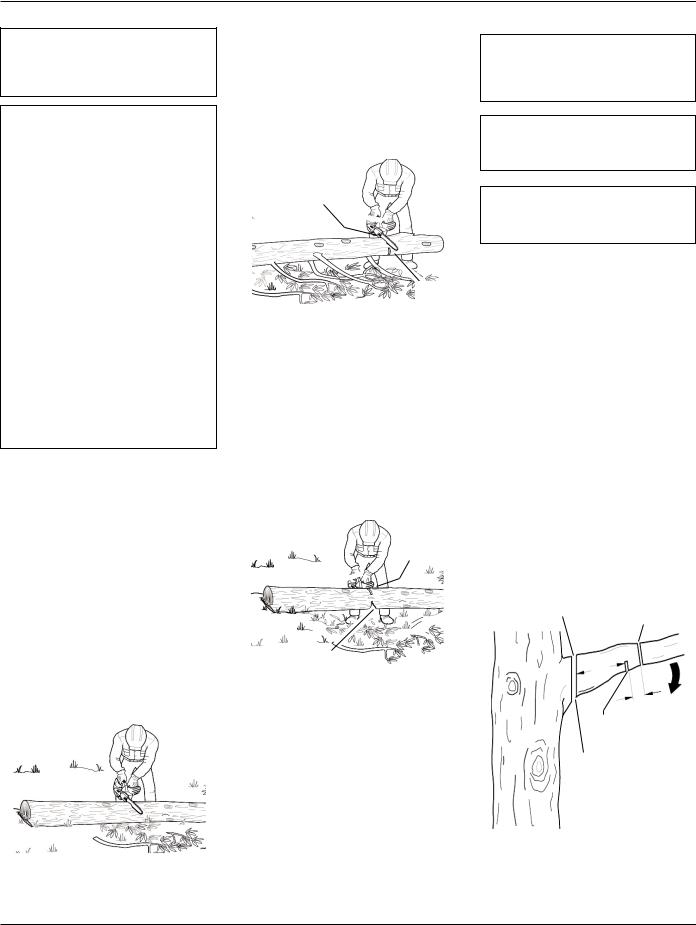
CHAIN SAW INFORMATION
BUCKING A LOG
 WARNING: Avoid kickback. Kickback can result in severe injury or death. See Kickback to avoid risk of kickback.
WARNING: Avoid kickback. Kickback can result in severe injury or death. See Kickback to avoid risk of kickback.
 WARNING:
WARNING:
•If on slope, make sure log will not roll down hill. Secure log by using wooden stakes. Drive wooden stakes into ground on downhill side of log. Stand on uphill side of log while cutting. Log may roll after cutting.
•Never try cutting through two logs at same time. This could increase the risk of kickback.
•Whilecuttinglog,neverhold log with your hand, leg, or foot.
•While cutting log, never allowanotherpersontohold log.
•Turn off and unplug saw before moving from one place to another.
Bucking a log is cutting a log into sections. Makesureyourfootingisfirm.Keepfeetapart. Divideyour weight evenly onbothfeet. When possible, raise log or section off ground. Do this by using limbs, logs, chocks, etc.
Whencuttingthroughlog,maintaincontrolby reducing cutting pressure near end of cut. Do not relax your grip on chain saw handles. Do not let moving chain touch ground. Ground will dull moving chain. After cutting through log, release trigger to turn saw off before moving saw.
Follow directions below to buck a log.
Entire Length Of Log On Ground
Cut log from top (see Figure 17).
Figure 17Bucking Log With Entire
Length On Ground
Log Supported On One End
1.Make first cut on underside of log (see Figure 18). Use top of guide bar to make this cut. Cut 1/3 through diameter of log. This cut will keep section from splintering when cut.
2.Make second cut directly above first cut. Cut down to meet first cut. This cut will keep log from pinching guide bar and chain.
2nd Cut
1st Cut
Figure 18 - Bucking Log When Log Is
Supported On One End
Log Supported On Both Ends
1.Make first cut from above log (see Figure 19). Cut 1/3 through diameter of log. This cut will keep section from splintering when cut.
2.Make second cut on underside of log, directly under first cut. Use top of guide bar to make this cut. Cut up to meet first cut. This will keep log from pinching guide bar and chain.
1st Cut
2nd Cut
Figure 19 - Bucking Log When Log Is
Supported On Both Ends
TRIMMING A TREE (PRUNING)
 WARNING: Avoid kickback. Kickback can result in severe injury or death. See Kickback to avoid risk of kickback.
WARNING: Avoid kickback. Kickback can result in severe injury or death. See Kickback to avoid risk of kickback.
 WARNING: Do not extend arms above shoulders when using polesaw.
WARNING: Do not extend arms above shoulders when using polesaw.
 CAUTION: Seek professional help if facing conditions beyond your ability.
CAUTION: Seek professional help if facing conditions beyond your ability.
Trimming a tree is the process of cutting limbs from a living tree. Make sure your footing is firm. Keep feet apart. Divide your weightevenlyonbothfeet.Followdirections below to trim a tree.
1.Make first cut six inches from tree trunk on underside of limb. Use top of guide bar to make this cut. Cut 1/3 through diameter of limb (see Figure 20).
2.Move two to four inches farther out on limb. Make second cut from above limb. Continue cut until you cut limb off.
3.Make third cut as close to tree trunk as possible on underside of limb stub. Use top of guide bar to make this cut. Cut 1/3 through diameter of stub.
4.Make fourth cut directly above third cut. Cut down to meet third cut. This will remove limb stub.
4th Cut - Final |
2nd Cut - Pruning |
Cut (to avoid |
|
Stub Cut |
pinching) |
6"
2" to 4"
1st Cut - Pruning Undercut (to avoid splintering)
3rd Cut - Stub Undercut (to avoid splintering)
Figure 20 - Cutting A Limb
www.remingtonpowertools.com |
14 |
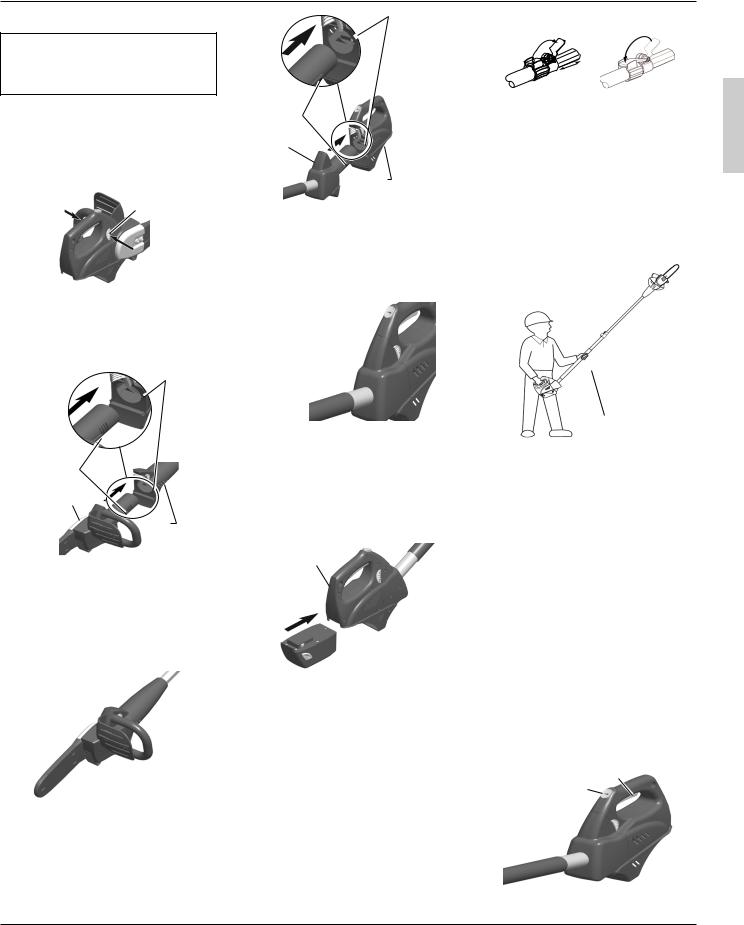
POLESAW INFORMATION
POLESAW ASSEMBLY
 WARNING: Cutting edges on chain are sharp. Use protective gloves when handling chain.
WARNING: Cutting edges on chain are sharp. Use protective gloves when handling chain.
1.Remove battery from chain saw.
2.Separate main handle from chain saw power head by pressing both release buttons on main handle and pulling apart (see Figure 21).
Press |
Release |
|
Release |
||
Button |
||
Buttons |
||
|
Figure 21Separate Main Handle from Powerhead.
3.Align rib on chain saw power head with groove in power head adapter on pole (see Figure 22).
Groove
Rib
Power Head
Polesaw Power Head Adapter
Figure 22 - Align Power Head with Power Head Adapter
4.Slide power head into power head adapter until units “snap” together (see Figure 23). IMPORTANT: Both release buttons on power head adapter must be fully engaged.
Figure 23 - Assembled Power Head and
Power Head Adapter
5.Align rib on handle adapter on pole with groove in main handle (see Figure 24).
Groove
Rib
Polesaw
Handle
Adapter
Main Handle
Figure 24 - Align Main Handle with Handle Adapter
6.Slide main handle into handle adapter until units “snap” together (see Figure 25). IMPORTANT: Both release buttons on main handle must be fully engaged.
Figure 25 - Assembled Main Handle and
Handle Adapter
7.Slide battery onto main handle until release buttons “snap” together (see Figure 26).
Note: Fully charge battery before using for first time. See Charging Battery, page 10
Main Handle
 Battery
Battery
Figure 26 - Assembled Battery onto Main Handle
ADJUSTING POLE LENGTH
The Remington brand polesaw has a telescoping pole assembly that will extend from 47 inches (fully retracted) to 83 inches (fully extended). A cam levered collet is used to hold the pole in position at any extended length.
1.To extend the pole, loosen the clamping lever (see Figure 27). Pole will slide freely.
2.Pull inner pole section out to desired length of extension. Note: Only extend pole to minimum length required to reach limb that is being cut.
3.To lock pole in position, tighten clamping lever (see Figure 27).
UNLOCK LOCK
Figure 27 - Extending Telescopic Pole
CUTTING WITH THE POLESAW
1.Attach battery to saw.
2.Use both hands to grip polesaw. Use only designated grip areas when operating polesaw (see Figure 28). Use firm grip. Thumbs and fingers must wrap around polesaw handle and pole.
3.Make sure your footing is firm. Keep feet apart. Divide your weight evenly on both feet.
Grip Area
Figure 28Designated Grip Areas
4.When ready to make a cut, press in trigger lockout and squeeze trigger (see Figure 29). This will turn polesaw on. Releasing trigger will turn polesaw off. Make sure saw is running before starting a cut.
5.When starting a cut, place moving chain against wood. Hold polesaw firmly in place to avoid possible bouncing or skating (sideways movement) of saw.
6.Guide polesaw using light pressure. Do not force saw. The motor will overload and can burn out. It will do the job better and safer at the rate for which it was intended.
7.Remove polesaw from a cut with saw running. at full speed. Stop polesaw by releasing trigger. Make sure chain has stopped before setting polesaw down.
Trigger
Trigger Lockout
Figure 29Polesaw Handle with Trigger Lockout
ENGLISH
15 |
www.remingtonpowertools.com |
